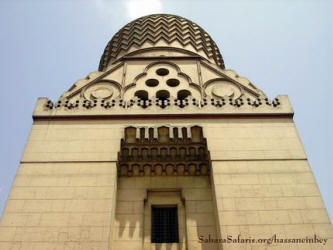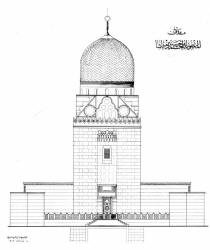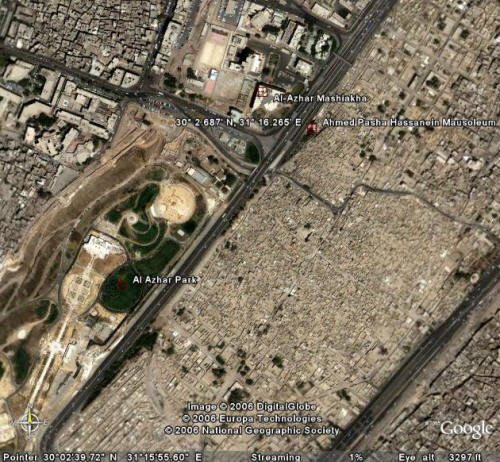 Origins Origins
Ahmed Mohamed Makhlouf Hassanein al-Bulaki.
His father was a Sheikh (Professor) at AlAzhar. His
grandfather is Ahmed Pasha Mazhar Hassanein the last Admiral of
the Egyptian fleet before dismantled by British upon occupying
Egypt in the 19th century less than a decade before Ahmed was
born.
Ahmed was born on 31st of October 1889
(Scorpio in Horoscopes) and brought up in Bulaq--the royal and
industrial Nile port of Cairo that befits the family of an
Admiral.

Education
He got his education first in Cairo and
then in Oxford University (Law?) and graduated 1914 at the
outbreak of WWI. He seems to have excelled fencing and have
represented Oxford university at one time. He then represented
Egypt in Olympics of Brussels 1920 then Paris 1924.
CareerHe started his career as the Arab Secretary
to the British Commanding Officer in Cairo (General Maxwell)
1914, during the Great War 1914-1918 (receivedMBE, 1915 star, British War and Victory medals, received GO
of the Orders of the Nile of Egypt, SS Maurice and Lazarus of
Italy, Pius of the Vatican, etc.).He was adviser to King Fuad 1925-1936,
tutor with Crown Prince Farouk in London at the time (same
building of Egyptian Embassy today in Mayfair), Chamberlain to
Queen Nazli 1936-1946. From 1940 and on, he was the most
influential man of Egypt.
Family
On 1926, Ahmed Bey married LutfiaHanem who was born 1905 (age 21 at marriage and 16 years
his junior) but then divorced later. Her mother is Princess
Shivakiar (Shewikar) Hanem Effendi (divorcee of King
Fuad) and her father is Sa7eb al Sa3ada Saifullah Yusri
Pasha (صاحب السعادة سيف الله يسرى باشا), first ever Egyptian Ambassador to Washington DC.
Ahmed had two sons and two daughters: Tarek, Hisham, Jayeda and Nazli.
Late Tarek (طارق) had two daughters:
Lutfia (لطفية) from his first marriage
Chahira (شهيرة) from his second marriage
Late Hisham (هشام) had only Seif (سيف)
Jayeda (جيدة) has two sons and one daughter:
Late Omar Mahmoud (عمر محمود)
Aziz Mahmoud (عزيز محمود)
and her daughter: Atteya Mahmoud (عطية محمود)
Late Nazli (نازلى) was unmarried.

From left to right: Tarek, Hisham, Jayeda, Nazli, and their mother Lutfia Hanem. (courtesy Mrs Jayeda Hassanein)
(please email
me if family wants to add here)
The End

On Tuesday 19th February 1946, Ahmed
Pasha was killed in an automobile accident in his car by a
British military car. He was buried in the
cemetery at Salah Salem St in a mausoleum built by the
internationally famous
Architect Hassan Fathy who was Ahmed's brother-in-law by marriage of his
sister Aziza Hassanein.
Hassanein's Mausoleum
The imposing mausoleum is a very famous landmark now that it
stands out at Salah Salem street in Cairo across from Al-Azhar
Mashiakha building.

In spite of its outstanding location of the mausoleum and that
it's seen by millions of Cairene everyday, the fact that the
legendary Explorer of the 1920s lying there and that it's been
built by Hassan Fathy is usually a surprise to everybody.
 
Map of Hassanein's Mausoleum
In Google, that's how it is located:

This is a satellite image and
not map so this commentary is needed. Street of Salah Salem is the
large diagonal black strip at the end of Al Azhar street coming from
upper left. Al Azhar Mashiakha Building is at the center of the upper
half and across Salah Salem street from it is where the Mausoleum is
located. Al Azhar Park is across Al Azhar street and is located with its
winding routes at the left half of this map. Coordinates in decimal
minutes are added so that GPS could be used to help find it.
Items of/about Ahmed Hassanein
The mysterious painting
(Sandra de Laszlo wrote on 17/3/2007 to Giancarlo Fochesato:
'We would be delighted to have the picture on the website described by Mohamed
Mabrouk -an excellent idea.') The reproduction (courtesy The de
Laszlo Archive & Trust, London) is in black & white only, as the present
location of the painting is sadly enough, unknown). We would be very grateful if any viewer can supply
information on the present whereabouts of the
portrait. E-mail to : desertmoh@yahoo.com,fochesatotts@yahoo.com,www.delaszloarchivetrust.com)
"I think de Lazlo fully succeeded in capturing
the many facets of Hassanein Bey's rich, elegant personality. As
well as the sitter's reserved and yet self-confident attitude
and true gentlemanship." wrote Giancarlo Fochesato
then added in another email:
"somebody not so familiar with de Laszlo's work, could be tempted to think that the artist painted it only partially and left it unfinished. But this is not the case.
As a matter of fact, it was typical of de Laszlo (particularly in the private and less official portraits) to intentionally leave some parts of the canvas unpainted. That added a sense of spontaneity, informality and movement to the sitter's pose and
helped avoid the conventional effect of so many social portraits."
De Laszlo Archive & Trust, London
On March 5th, 2007, Giancarlo Fochesato of Verona, Italy has
emailed Mohamed Mabrouk (author of this website) writing:
I was particularly delighted to find so exhaustive and
detailed an information on that extraordinary personality Ahmed
Hassanein Bey (or Pasha) [...]
Hassanein Bey was portrayed in London in 1927 by Sir
Philip de Laszlo (Budapest, 1869 - London, 1937), probably the
most celebrated social painter of the time. While the artist's
personal archive (now the property of the British National
Gallery, Heinz Foundation) keeps a b/w photograph of the
painting, its present location is unfortunately unknown to the
de Laszlo Foundation & Archive Trust, whose researchers staff
includes me among its members.
And to further explain the significance of the painter,
Giancarlo elaborated:
De Laszlo is thought to have painted 3,000 to 4,000
portraits in his long and successful career. (He always
regretted he had too little time to indulge in landscape
painting -which he did when holidaying or traveling. This minor
side of his production -in terms of quantity, not of artistry-
includes a few delightful Egyptian landscapes and Cairo &
Alexandria street scenes.) Among de Laszlo's sitters were
royalty, nobility and the rich & famous of his time, which
Hassanein Bey surely was out of his own merits and outstanding
brilliant talents.
A mystery
that is yet to be resolved
After being connected with the Hassanein family, Giancarlo
has reported:
Ms. Mahmoud was kind enough and directly contacted me last week. Unfortunately, as it turned out, the portrait of her grand father (like many other personal belongings of Hassanein Pasha) is no more in the possession of the family. In Ms. Mahmoud's own words, only 'a miracle' would make it possible to find out where the painting is presently located and who is the owner.
Now, you .. yes YOU reader! You think you can help with
this?! If so, email
me or the other emails mentioned above.
Book
Dedication by Hassanein for "English Patient's" Catherine
CliftonSpecial Hand-written dedication
in Cairo by Hassanein Pasha on his book The Lost Oases to Lady Clayton
East-Clayton dated March 14th, 1933:

Lady Clayton
(born Dorothy Mary Durrant) has been featured in The English
Patient movie as Catherine Clifton. She died on 15 September
1933 (exactly 6 months after this written dedication) in a plane accident in England, which is a year after the death of
her husband Sir Robert Clayton East-Clayton who was --with his wife-- established patrons of Explorers to the Libyan Desert. Her death in the
movie The English Patient is --as well as her love story with Almasy-- pure
fiction and seems to be unfounded. (Thanks
Lajos N�meth
for providing the scanned image)
| 